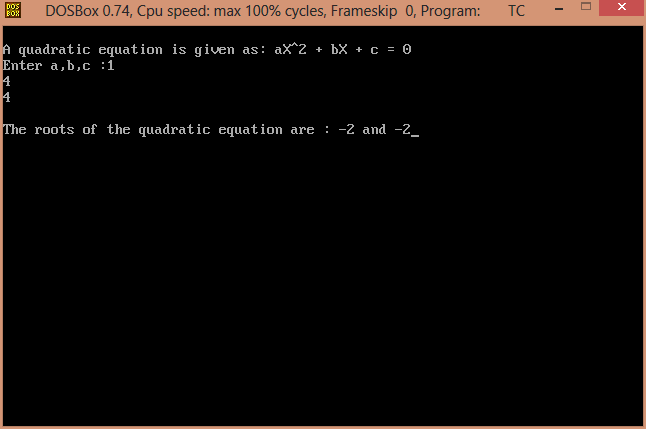I am supposed to write a program that asks for the coefficients a, b, and c of a quadratic equation ax2+bx+c=0. It needs to display to the screen one of the following:
• two distinct real numbers (when b2-4ac > 0),
• two distinct complex numbers (when b2-4ac < 0), or
• one real number (when b2-4ac = 0)
Weaving it together 3 pdf. Weaving It Together 1 Milada Broukal download Z-Library. Download books for free. Weaving it together Item Preview remove-circle. Download 1 file. ENCRYPTED DAISY download. For print-disabled users. 14 day loan required to access EPUB and PDF files. Books to Borrow. Books for People with Print Disabilities. Internet Archive Books.
- Program and application that were also utilized during the development process is Dev-c compiler. The Dev-c compiler was to compile, run and debug the program. The programs is been written in modules, the first modules deals with the input of data, computation and display on the screen, the input of data concerning the value of the quadratic equation of ax 2 + bx + c = 0, while the second module is the control structure were it.
- Each of the solutions given by the quadratic formula is called a root of the quadratic equation. Geometrically, these roots represent the x values at which any parabola, explicitly given as y = ax2 + bx + c, crosses the x -axis. As well as being a formula that will yield the zeros of any parabola.
- Hi, I am trying to make a variable equation solver using DEV-C. I just need to know how to get C to solve an equation inputed by the user. So you input something like 1+1 and i need it to solve the problem and output the answer. Heres an example.
- For a quadratic equation ax 2 +bx+c = 0 (where a, b and c are coefficients), it's roots is given by following the formula. The term b 2 -4ac is known as the discriminant of a quadratic equation. The discriminant tells the nature of the roots. If discriminant is greater than.
Solve an equation of the form Ax^2 + Bx + C = 0. The class is commented, but if you have any questions don't be affraid to ask. You may exercise this class in a console application with the following snippet: QuadraticEquation z = new QuadraticEquation(1, 3, 3); z.Solve; Console.WriteLine('D=0. Solution a=1 b=-3 c=4 # Solutions found: 0 Solution a=1 b=-4 c=4 # Solutions found: 1 x=2 Solution a=1 b=-5 c=4 # Solutions found: 2 x=4 x=1 Solution a=9 b=30 c=25 # Solutions found: 1 x=-1,6667 Solution a=9 b=-15 c=25 # Solutions found: 0. I am using Dev C compiler.i have the C code to solve a quadratic equation.the.exe file runs very well and provide the required solutions.my problem is that i want the program to function in a gui environment still using C language and the same Dev C compiler.possible?please help.! 4/5/16, 9:41 PM. To understand this example to Find Quadratic Equation Roots, you should have the knowledge of following C programming topics: C if, ifelse and Nested ifelse; For a quadratic equation ax 2 +bx+c = 0 (where a, b and c are coefficients), its roots are given by following the formula.
I have worked the following program and it doesn't work when set up this way:
If I change the last statement to 'if else' the program works, but I don't think that would be correct. Please help.
Solving Quadratic Equations Calculator
The standard form of a quadratic equation is: ax 2 + bx + c = 0, where a, b and c are real numbers and a!= 0 The term b 2 -4ac is known as the discriminant of a quadratic equation. It tells the nature of the roots.
TRAKTOR SCRATCH is now included in TRAKTOR PRO 3, right out of the box. This means that DVS DJs using timecode vinyl can now use any soundcard they like, in addition to tried and tested, TRAKTOR SCRATCH Certified soundcards and mixers. Traktor scratch pro timecode kit.


- 3 Contributors
- forum 4 Replies
- 827 Views
- 7 Hours Discussion Span
- commentLatest Postby abhimanipalLatest Post
Dave Sinkula2,398
I am supposed to write a program that asks for the coefficients a, b, and c of a quadratic equation ax2+bx+c=0. It needs to display to the screen one of the following:
• two distinct real numbers (when b2-4ac > 0),
• two distinct complex numbers (when b2-4ac < 0), or
• one real number (when b2-4ac = 0)
I have worked the following program and it doesn't work when set up this way:
If I change the last statement to 'if else' the program works, but I don't think that would be correct. Please help.
It's a syntax error as written, and won't compile, so it can't be run. Why would you think this is more correct?
You're also not declaring a, b, and c. Please post actual code and wrap it in code tags.
Quadratic Formula In C
It would be less redundant to use a temporary, say
Dev C++ Quadratic Equation Worksheet

instead of recalculating it several times. It is also cleaner, clearer, and easier to read.
How do you solve #x^2+14x=0 # using the quadratic formula?
2 Answers
Explanation:
Quadratic Formula
Substitute:
a term = 1
b term = 14
c term = 0
Evaluate:
Looking for alaska pdf free download. Solve to find the two roots of x
Explanation:
Not disagreeing with Dèv, but there is another(and even easier) way to solve it:
In a quadratic function, whenever

So, the 2 possibilities:
Dev C++ Download Windows 10
The second possibility we may finish solving it:
Now, we do solve it the same way we did it before:
So, the roots of a quadratic function with
Dev C++ For Windows 10
Related questions
